Introduction
Disease lesion mimics are a class of mutants in plants that spontaneously form lesions (patches of dead cells) in the absence of any obvious injury, stress or infection to the plant. Initially, these mutants were thought to have resulted solely from defects in genes and pathways that are normally called into action during the infectious encounters of plants with pathogens, and were therefore named disease lesion mimics (27,34). While this is true with some of these mutants, recent studies have demonstrated that the "disease" underlying disease lesion mimic mutants encompasses much more than simply mimicking plant responses to pathogens. As described in detail later, these lesioned mutants (abbreviated les or Les for recessive and dominant mutants, respectively) result from aberrations in all sorts of biological processes, with loss of cellular homeostasis (stable equilibrium within the cell) a common feature that eventually results in the death of affected cells (7,17,22).
The Repertoire of Maize Les/les Mutants
Lesion mimic (Les/les) mutants are present ubiquitously in plants. In Arabidopsis, they have been described by many names, including lesions simulating disease (lsd) or accelerated cell death (acd) mutants (7,22), and in rice they are called spotted leaf (spl) mutants (35,36). In maize (Zea maydis), where lesion mimics were isolated first, more than 50 loci (positions in a chromosome) have been identified that give rise to a lesioned phenotype when aberrant (4,17,34). Intriguingly, more than half of these mimics inherit in a partially or completely dominant fashion, making them the largest class of gain-of-function mutations in maize.
Almost every Les/les mutant is unique in some aspect and produces different symptoms on affected plants. The phenotypes vary, with lesions ranging in number from a few to many, in size from minute flecks to lesions that cover the whole leaf, and in color from dark brown to chlorotic or even translucent (Figs. 1 through 5). In shape, lesions of most Les/les mutants are more or less circular, but there is at least one mutant (les*-2014) in which lesions form along the length of the leaf (Fig. 6). In most Les/les mutants, lesions are confined to the leaf blade, but a few mutants also form lesions on the leaf sheath and stalk (Fig. 7), causing the plants to lodge or collapse prematurely.
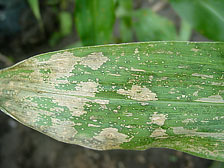 |
|
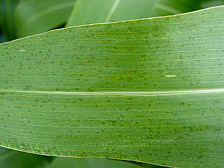 |
|
Fig. 1. Initiation and expansion of Les6 lesions. |
|
Fig. 2. Les9 lesions appear as water soaked spots immediately following their initiation. Later these lesions turn yellowish brown as shown in Fig. 10. |
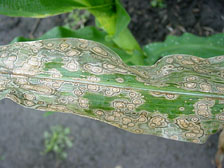 |
|
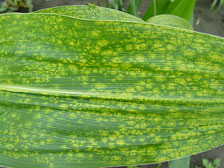 |
|
Fig. 3. Highly concentric and expanding lesions of lls1 that engulf the entire leaf. |
|
Fig. 4. Typical chlorotic lesions underlying Les39. |
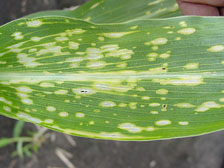 |
|
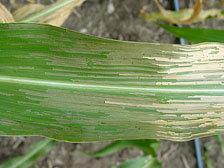 |
|
Fig. 5. Translucent lesions of les54, which was previously called clear-spotted mutant. |
|
Fig. 6. Long and narrow lesions of les*-2014. Initially the lesions appear as water soaked streaks that collapse within a day or two to exhibit the typical dried-up appearance. |
| |
Fig. 7. Typical Les4 lesions that form not only on leaf blades but also on the leaf sheath, husks and eventually on lower stalk internodes, causing the plant to break. |
|
Depending on how lesions behave following inception (initiation), Les/les mutants can be divided into two general categories: determinative and propagative (7,17). In determinative mimics, lesions are often initiated profusely but then are restricted in size, giving the illusion of a massive hypersensitive response (HR), a kind of suicidal reaction of plant cells triggered in response to invasion by incompatible pathogens (7). In contrast, propagative mimics form lesions relatively sparingly, but once formed lesions often expand uncontrollably to kill the entire leaf and even the entire plant (7,22). It is presumed that lesions in the determinative mimics class arise from impairments that result in the lowering of the threshold for cell death initiation. In comparison, propagative mimics are thought to represent defects in genes that encode negative regulators of cell death in plants. It should be emphasized, however, that not all mutants fall cleanly into these two categories; there are a number of mutants that initially cause discrete lesions but ultimately cause the affected leaves to senesce and collapse much earlier than the corresponding leaves on wild-type siblings.
Factors Affecting Les/les Mutants
Although Les/les mutants are strictly Mendelian mutants, their phenotype is easily influenced by a number of other factors, both external (environmental) and internal (host factors), causing many lesion mimic mutants to behave as conditional mutants.
Environmental factors
· Light. Among the environmental factors, light appears to be most important in mediating lesion formation. A vast majority of the maize mimic mutants require light for the initiation and/or propagation of lesions (4,15,17). The effect of light on Les/les mutants can be easily revealed by covering a part of the leaf with aluminum foil or some dark paper that prevents light from reaching the leaf (11,15,31). Alternatively, light effect can be shown by introgressing Les/les into other mutant backgrounds that are deficient in chlorophyll accumulation and/or some other aspect of photosynthesis. Experiments with such double mutants have demonstrated that it is the incident light that is important for lesion initiation and/or propagation for certain Les/les mutants (15), but it is the light harvested for photosynthesis that fuels lesion formation in other mutants (11).
· Temperature. Temperature also plays an important role in the initiation of lesions accompanying many mimics. In some cases, there may be a strict requirement of temperature [for instance, the phenotype of Les1 only manifests optimally at temperatures below 60°F (13)], but, in general, most Les/les mutants exhibit a severe phenotype when the temperature is high and the light is bright (17).
· Glasshouse vs. field-grown plants. Finally, the overall growing conditions, especially whether the plants are growing in a glasshouse or in the field, also have a major impact on the severity of Les/les mutants. Intriguingly, compared to field conditions, phenotypes of some of these mutants are enhanced under greenhouse conditions, while phenotypes of others are suppressed (Johal, unpublished data). These observations suggest complex interactions between Les/les mutants and environmental factors.
Host factors
· Developmental factors. Almost all maize Les/les mutants are programmed to manifest their phenotype in a developmentally specified fashion. While some of them are expressed around the time of flowering (Les4, for example) or later, a vast majority of them begin expression about 3-4 weeks after planting. In the latter case, lesions first appear as tiny spots near the tip of the first leaf of field-grown mutant plants, about 4-weeks after emergence. These lesions enlarge in size while new ones emerge down the leaf blade following a basipetal gradient. This results in the entire leaf being covered with lesions in 4-5 days. Meanwhile, lesions have already started to develop near the tip of the second leaf (Fig. 8). This pattern continues until the plant is fully covered with lesions, shortly around pollen shed (10,31). What dictates this developmental behavior of Les/les mutants remains unknown.
| |
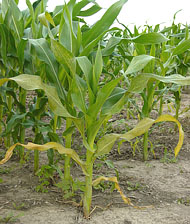
Fig. 8. Typical progression of a Les/les phenotype as the plant develops. The mutant shown here is Les17. |
|
· Genetic background factors. It is well known that the penetrance (whether or not a given phenotype is detected) and expressivity (phenotypic severity) of Mendelian mutants are easily influenced by the genome (the genetic background) in which they reside. Nowhere is it more dramatic than with the maize Les/les mutants which may have a lethal phenotype in one genetic background but a benign one in another (29). A number of maize inbred lines have been identified that markedly dampen or exacerbate symptoms associated with many of the lesion mimic mutants. For example, the inbred Mo20W, which remains green for prolonged periods after fertilization, tends to suppress many Les/les mutants when introgressed into its genome (10,29,31). In contrast, many of these mimics express so severely in the inbred W23 background that the mutant plant either dies before reaching maturity or fails to produce seed (29).
The dramatic nature of the genetic background effect on maize lesion mimics was first demonstrated by Neuffer, who was also the first one to unveil Les/les mutants as a unique phenomenon in plants (13,29). Employing simple genetic crosses involving inbred Mo20W and Les1 in the inbred W23 background (Les1::W23), it was found that the suppressible effect of Mo20W on Les1 was dominant over its optimal expression in W23. When F2 populations of this cross were evaluated, a range of mutant phenotypes, with varying degrees of severity, were found segregating in the progeny, indicating the involvement of multiple genetic factors in shaping the phenotype of Les1.
One intriguing implication of this study was that the exquisite sensitivity of the Les/les phenotype to a maize genetic background could be used as an indicator or reporter to delineate the nature of this poorly-understood but ever-present genomic variable in maize. We addressed this possibility by taking advantage of les23, a recessive loss-of-function mutant, and a QTL (quantitative trait locus) approach, which was based on an F2 population derived from a cross between les23 and Mo20W (31). This study led us to identify a strong QTL that was able to contribute to more than 70% of the variation in les23 phenotypes present in this population. This QTL, which we have named Slm1 (suppressor of lesion mimics-1), has been mapped to the long arm of chromosome 2 in maize. A few minor QTL were also identified that together with Slm1 completely suppress les23 (31). Similar studies with Rp1-D21, a partially dominant Les mutant resulting from an aberration in the maize Rp1 disease resistance gene, have uncovered additional suppressors like Slm1 (Johal, Balint-Kurti et al., unpublished data).
In fact, so common are these suppressors in the maize germplasm that they can also cause a lesion mimic mutant to become cryptic. A case in point is inbred Mo17 whose hybrid with B73 was used commercially in the 1960s and 1970s. Using IBM RILs (IBM = intermated B73 and M017; RIL = recombinant inbred lines) between these two lines as well as segregating F2 populations of Mo17 with B73 and four other inbred lines, we were able to reveal a les locus in Mo17, which we have named les-Mo17 (Penning, Johal et al., unpublished data). However, les-Mo17 is prevented from manifesting a phenotype in Mo17 because of the presence of two unlinked suppressors in this inbred. However, when these suppressors segregate away from les-Mo17 (as accomplished in the IBM RILs or F2 populations), les-Mo17 reveals itself by expressing a les phenotype.
Les/les Effect on Maize Diseases
It has been well documented in Arabidopsis that Les/les mutants often enhance the ability of plants to resist diseases, especially those that are caused by pathogens using biotrophic lifestyles for invasion (22). Similar observations have been made in rice in which many of the Spl/spl mutants induce systemic acquired resistance (SAR) to the rice blast pathogen (Magnaporthe grisea) (35,36). This, however, does not seem to be the case in maize. With the exception of Rp1-derived Les/les mutant causing broad spectrum resistance against the rust pathogen Puccinia sorghi (14), most maize Les/les mutants have not been found to induce effective SAR to any of the pathogens that have been studied in detail. This includes the leaf spot pathogen Cochliobolus carbonum, a necrotroph, and the common rust pathogen P. sorghi, an obligate biotroph. Instead of the pathogen being suppressed, P. sorghi has been found to suppress lesions associated with a few Les/les mutants (Fig. 9). While SAR has not been observed to be induced by maize Les/les mutants, local induction of resistance has been seen in some cases. A dramatic example of this is provided by Les9 which suppresses largely the symptoms associated with the gray leaf spot disease caused by Cercospora zea-maydis (Fig. 10). Why maize Les/les mutants differ from other plants with regard to their ability to induce SAR is unknown.
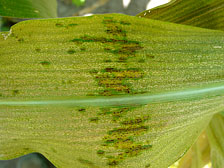 |
|
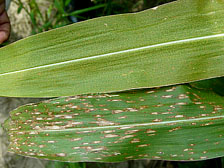 |
|
Fig. 9. Cell death underlying Les29 lesions is suppressed in the vicinity of common rust pustules, thereby producing areas of protected leaf tissue that plant pathologists often refer to as 'green islands.' |
|
Fig. 10. Leaves of two sibling plants carrying or lacking the Les9 mutation. While the wild-type leaves (bottom) were inundated by infection by the gray leaf spot pathogen (C. zea-maydis), Les9 leaves (top) exhibited a high level of resistance to the pathogen. |
Why Study Lesion Mimics?
Lesion mimic mutants exhibit two key features that have aroused much interest in their investigation. First, as mentioned earlier, they often exhibit induction of defense responses which are typically upregulated at the time of pathogen infection (7,17,22). This association has led many researchers to believe that lesion mimic mutants represent a valuable resource for studying the intricacies of plant defense without having to worry about the compounding effects from pathogens.
The second feature is the ubiquitous association of these mimics with cell death, which either happens precociously in these mutants or is not contained adequately following normal onset. As a result, ideas have been elaborated to suggest that Les/les mutants represent defects in genes and mechanisms that control the programmed death of cells and tissues in plants (7,17). Programmed cell death (PCD) is as important in plants as it is in animals; it serves many essential roles in the growth and development of plants, as well as in their defense against biotic and abiotic stresses (7,19). Despite the importance of PCD, our knowledge of how plants regulate and accomplish PCD remains rudimentary.
In contrast, great advances have been made in animals over the last decade to show that the cellular machinery of PCD, also called apoptosis, are largely conserved from worms to humans (32). For instance, cells that are fated to die apoptotically shrink and their cell and nuclear membranes undergo blebbing (formation of irregular bulges in membranes). This is followed by breakage and packaging of cellular contents into vesicles called apoptotic bodies, which are phagocytosed (consumed) by neighboring cells. Meanwhile, the nuclear DNA of dying cells is degraded, first into high molecular weight DNA and subsequently into oligonucleosomal ladders. Such apoptotic dismantling of the cell is brought about by a class of cysteine proteases termed caspases. Produced as zymogens (inactive enzyme precursors), the processing, activation and function of caspases is controlled by the opposing action of an ever-increasing number of cell death suppressors and enhancers. Mitochondria play a central role in this battle of pro-death versus anti-death factors. Their integrity is breached when pro-death factors outcompete the anti-death factors, causing mitochondria to release a slew of molecules (including cytochrome C) that then activate caspases (2,6,32).
Although some progress has been made recently in plant PCD (12,20), no such framework of genes and mechanisms has yet emerged that may underlie PCD in plants. So it is hoped that an exploration of the Les/les phenomenon will fill this void and provide valuable information concerning how cell death is signaled, controlled, and executed in plants. Given what the recent cloning and subsequent characterization of a number of lesion mimic genes from Arabidopsis, maize, barley, rice and tomato have revealed (4,22), there are ample reasons to be excited about this possibility.
Why So Many Mimics?
The Les/les phenotype has emerged as one of the most common mutant phenotypes in plants. As mentioned earlier, more than 50 Les/les loci have been identified in maize, and judging from the rate at which new lesion mimic mutations are being identified in Arabidopsis, a similar number may soon be approaching in this dicot model as well. In maize, Les/les loci have been found to scatter all over the genome (28), and only a few of them exist as multiple mutant alleles. Extrapolating from this general lack of confirmed allelic pairs, it has been suggested that more than 200 Les/les loci might exist in maize (34).
The question arises: why are there so many mimic mutation loci in plants? The recent cloning and characterization of a number of lesion mimic genes have provided significant insights into this question [reviewed in (4,22)]. It appears that lesion mimic mutations can result from a variety of mechanisms, some of which include:
· Genetic aberrations in plant R genes (disease resistant genes) (14,33,37). A key example is that of the maize Rp1 gene that confers resistance to the common rust pathogen Puccinia sorghi. As mentioned earlier, alleles of this gene have been identified that trigger hypersensitive cell death response (HR) spontaneously. These alleles have undergone simple changes in their structure that result in autoactivation of the RP1 protein, which, like other R genes, is normally kept in check by both intra- and intermolecular interactions.
· Defects in genes downstream of R genes. A classic example of this is the tomato nec1 gene which is required for proper functioning of the Cf2 disease resistance gene (9,18).
· Defects in genes that may work at the interface of PCD and defense signaling (5,35). The mlo mutant of barley is a case in point. It is defective in a seven membrane protein that modulates resistance at the level of cell wall and cell death. A recent example of this is the rice Spl11 gene which is defective in an E3 ligase (36).
· Mutations in genes involved in reactive oxygen intermediates (ROI) accumulation and management (8,25). Excessive production and/or excessive accumulation of ROI is probably the most common mechanism underlying the etiology of Les/les mutants. This happens in the case of the Arabidopsis lsd1 mutant which is defective in a zinc-finger protein. The phenotypes of the Arabidopsis acd2 and maize lls1 mutants, which have defects in chlorophyll degradation, result from light-dependent production of singlet oxygen (10,24). The maize Les22 mutant, which is defective in chlorophyll biosynthesis (15), also owes its lesion mimic phenotype to singlet oxygen.
· Defects in cell death pathway(s) mediated by ceramides, a family of lipid molecules composed of sphingosine and a fatty acid, and found in high concentrations in cell membranes (3,21,23). This is exemplified by the acd5 and acd11 genes of Arabidopsis, which have lesions in a ceramide kinase and sphingosine transfer protein, respectively (3,21).
· Errors or impairments in metabolism (15). The maize mutant Les22, which is defective in a single copy of the gene Urod that encodes an enzyme of tetrapyrrole biosynthesis (15), is a key example of this. The maize lls1 and the Arabidopsis acd2, which encode pheophorbide oxidase and RCC reductase (two consecutive enzymes of the chlorophyll degradation pathway) exemplify another set of mutants belonging to this class (10,24).
· Errors in various membrane associated functions (1,16). These defects are highlighted by the Arabidopsis ssi2, (defective in a plastidic stearoyl-acyl-carrier protein desaturase), acd6 (defective in ankyrin-repeat domain containing transmembrane protein), hlm1 (defective in a cyclic nucleotide gated ion channel), cpn1 (defective in calcium-dependent, phospholipids binding proteins called copines), cpr5 (defective in a novel five transmembrane domain protein), and nsl1 (defective in a membrane attack complex/perforin domain containing protein (reviewed in 22).
· Aberrations in vesicle mediated transport. A classic case of this is the barley mlo mutant which is defective in a serpentine membrane protein, a regulator of wall based penetration resistance to fungal pathogens of the powdery mildew class. MLO appears to do so by regulating the functioning of various SNARE proteins (soluble N-ethylmaleimide sensitive fusion protein attachment receptors) (30). We have also unveiled a similar lesion mimic mutant in maize. The rust mimic-1 mutant is defective in a SNAP-25 (synaptosome-associated protein of 25,000 daltons) homologue and as a result results in light-dependent lesion mimicry (Johal et al., unpublished data)
In addition, the lesion mimic phenotype has also been found to be readily induced by a variety of transgenes, including those that normally perform house-keeping functions in cells [reviewed in (26)], suggesting that whenever things get out of sync (general loss of homeostasis), plant cells are tripped to embrace pathways leading eventually to their demise.
Conclusion
The Les/les phenotype is emerging as one of the most common stress phenotypes in plants. These mutants encompass much more than simply mimicking plant responses to pathogens. One useful aspect of the Les/les phenotype is that it can be discerned and quantified rather easily, making it an excellent indicator (reporter) of stress in plants. Les/les mutants thus provide a unique opportunity to look into genes and pathways that enhance or suppress the extent of stress associated with these mutants. A better understanding of the biology of Les/les mutants and the genes and mechanisms that impact their etiology holds promise for generating crops capable of withstanding all sorts of stresses that plants have to face in an ever-changing environment.
Literature Cited
1. Balague, C., Lin, B., Alcon, C., Flottes, G., and Malmstrom, S., et al. 2003. HLM1, an essential signaling component in the hypersensitive response, is a member of the cyclic nucleotide-gated channel ion channel family. Plant Cell 15:365-379.
2. Barisic, K., Petrik, J., and Rumora, L. 2003. Biochemistry of apoptotic cell death. Acta Pharm. 53:151-164.
3. Brodersen, P., Petersen, M., Pike, H. M., Olszak, B., and Skov, S., et al. 2002. Knockout of Arabidopsis accelerated-cell-death11 encoding a sphingosine transfer protein causes activation of programmed cell death and defense. Genes Dev. 16:490-502.
4. Buckner, B., Johal, G. S., and Janick-Buckner, D. 2000. Cell death in maize. Physiol. Plant. 108:231-239.
5. Buschges, R., Hollricher, K., Panstruga, R., Simons, G., and Wolter, M., et al. 1997. The barley Mlo gene: a novel control element of plant pathogen resistance. Cell 88:695-705.
6. Cory, S., and Adams, J. M. 2002. The Bcl2 family: Regulators of the cellular life-or-death switch. Nat. Rev. Cancer 2:647-656.
7. Dangl, J. L., Dietrich, R. A., and Richberg, M. H. 1996. Death don't have no mercy: Cell death programs in plant-microbe interactions. Plant Cell 8:1793-1807.
8. Dietrich, R. A., Richberg, M. H., Schmidt, R., Dean, C., and Dangl, J. L. 1997. A novel zinc finger protein is encoded by the arabidopsis LSD1 gene and functions as a negative regulator of plant cell death. Cell 88:685-694.
9. Dixon, M. S., Golstein, C., Thomas, C. M., van Der Biezen, E. A., and Jones, J. D. 2000. Genetic complexity of pathogen perception by plants: the example of Rcr3, a tomato gene required specifically by Cf-2. Proc. Natl. Acad. Sci. USA 97:8807-8814.
10. Gray, J., Close, P. S., Briggs, S. P., and Johal, G. S. 1997. A novel suppressor of cell death in plants encoded by the Lls1 gene of maize. Cell 89:25-31.
11. Gray, J., Janick-Buckner, D., Buckner, B., Close, P. S., and Johal, G. S. 2002. Light-dependent death of maize lls1 cells is mediated by mature chloroplasts. Plant Physiol. 130:1894-1907.
12. Hatsugai, N., Kuroyanagi, M., Yamada, K., Meshi, T., and Tsuda, S., et al. 2004. A plant vacuolar protease, VPE, mediates virus-induced hypersensitive cell death. Science 305:855-858.
13. Hoisington, D. A., Neuffer, M. G., and Walbot, V. 1982. Disease lesion mimics in maize. I. Effect of genetic background, temperature, developmental age, and wounding on necrotic spot formation with Les1. Dev. Biol. 93: 381-388.
14. Hu, G., Richter, T. E., Hulbert, S. H., and Pryor, T. 1996. Disease Lesion Mimicry Caused by Mutations in the Rust Resistance Gene rp1. Plant Cell 8:1367-1376.
15. Hu, G., Yalpani, N., Briggs, S. P., and Johal, G. S. 1998. A porphyrin pathway impairment is responsible for the phenotype of a dominant disease lesion mimic mutant of maize. Plant Cell 10:1095-1105.
16. Jambunathan, N., Siani, J. M., and McNellis, T. W. 2001. A humidity-sensitive Arabidopsis copine mutant exhibits precocious cell death and increased disease resistance. Plant Cell 13:2225-2240.
17. Johal, G. S., Hulbert, S. H., and Briggs, S. P. 1995. Disease lesion mimics of maize - a model for cell-death in plants. Bioessays 17:685-692.
18. Kruger, J., Thomas, C. M., Golstein, C., Dixon, M. S., and Smoker, M., et al. 2002. A tomato cysteine protease required for Cf-2-dependent disease resistance and suppression of autonecrosis. Science 296:744-747.
19. Kuriyama, H., and Fukuda, H. 2002. Developmental programmed cell death in plants. Curr. Opin. Plant Biol. 5:568-573.
20. Lam, E. 2005. Vacuolar proteases livening up programmed cell death. Trends Cell Biol. 15:124-127.
21. Liang, H., Yao, N., Song, J. T., Luo, S., Lu, H., and Greenberg, J. T. 2003. Ceramides modulate programmed cell death in plants. Genes Dev. 17:2636-2641.
22. Lorrain, S., Vailleau, F., Balague, C., and Roby, D. 2003. Lesion mimic mutants: keys for deciphering cell death and defense pathways in plants? Trends Plant Sci. 8:263-271.
23. Lu, H., Rate, D. N., Song, J. T., and Greenberg, J. T. 2003. ACD6, a novel ankyrin protein, is a regulator and an effector of salicylic acid signaling in the Arabidopsis defense response. Plant Cell 15:2408-2420.
24. Mach, J. M., Castillo, A. R., Hoogstraten, R., and Greenberg, J. T. 2001. The Arabidopsis-accelerated cell death gene ACD2 encodes red chlorophyll catabolite reductase and suppresses the spread of disease symptoms. Proc. Natl. Acad. Sci. USA 98:771-776.
25. Mateo, A., Muhlenbock, P., Rusterucci, C., Chang, C. C. C., and Miszalski Z, et al. 2004. Lesion simulating disease 1 - Is required for acclimation to conditions that promote excess excitation energy. Plant Physiol. 136:2818-2830.
26. Mittler, R., and Rizhsky, L. 2000. Transgene-induced lesion mimic. Plant Mol. Biol. 44:335-44
27. Neuffer, M. G., and Calvert, O. H. 1975. Dominant disease lesion mimics in maize. J. Heredity 66:265-270.
28. Neuffer, M. G., Coe, E. H., and Wessler, S. R. 1997. Mutants of Maize. Cold Spring Harbor Lab. Press, New York, NY.
29. Neuffer, M. G., Hoisington, D. A., Walbot, V., and Pawar, S. E. 1983. The genetic control of disease symptoms. Pages 123-134 in: Gene Structure and Function in Higher Plants. Oxford and IBH Pub. Co, New Delhi, India.
30. Panstruga, R. 2005. Serpentine plant MLO proteins as entry portals for powdery mildew fungi. Biochem. Soc. Trans. 33:389-392.
31. Penning, B. W., Johal, G. S., and McMullen, M. D. 2004. A major suppressor of cell death, slm1, modifies the expression of the maize (Zea mays L.) lesion mimic mutation les23. Genome 47:961-969.
32. Raff, M. 1998. Cell suicide for beginners. Nature 396:119-122.
33. Shirano, Y., Kachroo, P., Shah, J., and Klessig, D. F. 2002. A gain-of-function mutation in an Arabidopsis Toll Interleukin1 receptor-nucleotide binding site-leucine-rich repeat type R gene triggers defense responses and results in enhanced disease resistance. Plant Cell 14:3149-3162.
34. Walbot, V., Hoisington, D. A., and Neuffer, M. G. 1983. Disease lesion mimic mutations. Pages 431-442 in: Genetic Engineering of Plants. Plenum Publ. Corp., New York, NY.
35. Yin, Z., Chen, J., Zeng, L., Goh, M., and Leung, H., et al. 2000. Characterizing rice lesion mimic mutants and identifying a mutant with broad-spectrum resistance to rice blast and bacterial blight. Mol. Plant Microbe Interact. 13:869-876.
36. Zeng, L. R., Qu, S., Bordeos, A., Yang, C., and Baraoidan, M., et al. 2004. Spotted leaf11, a negative regulator of plant cell death and defense, encodes a U-box/armadillo repeat protein endowed with E3 ubiquitin ligase activity. Plant Cell 16:2795-2808.
37. Zhang, Y., Goritschnig, S., Dong, X., and Li, X. 2003. A gain-of-function mutation in a plant disease resistance gene leads to constitutive activation of downstream signal transduction pathways in suppressor of npr1-1, constitutive 1. Plant Cell 15:2636-2646.
